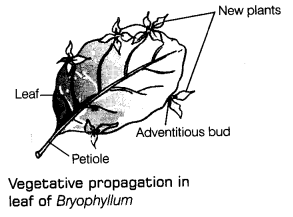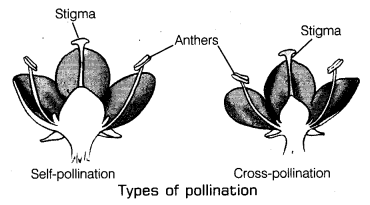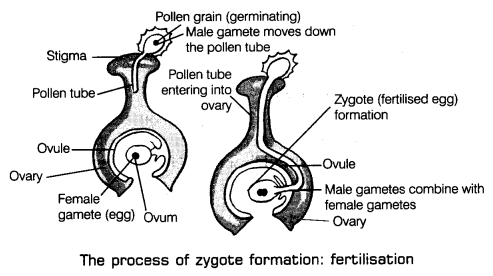CBSE Class 7 Science Notes Chapter 12 Reproduction in Plants
All the living organisms including plants and animals have the capability to produce new individuals during their lifespan. This process of producing a new organism from the existing organism (or the parent) of the same species is called reproduction. The new individuals produced, are the copies of their parents. The process of reproduction is one of the important life processes and is essential for the continuity of the species.
Thus, reproduction makes the life continuous which is not only essential for the survival of an organism but it is also very necessary for the perpetuation and preservation of the species because it increases the number of members of a species.
Modes of Reproduction
The various parts of a plant such as roots stem and leaves each with a specific function is called vegetative parts. After a certain period of growth, plants bear flowers. These flowers develop into fruits and seeds.
The parts of a plant that participate in the process of sexual reproduction are called reproductive parts or organs. In plants, the reproductive parts are a flower which may have the male or female part or both the parts on the same flower.
Different organisms reproduce in a different way. In plants, there are two different methods of reproduction:
- Asexual reproduction
- Sexual reproduction
The term ‘sexual’ means involving the fusion of sex cells or gametes while ‘asexual’ means without involving the fusion of gametes.
Asexual Reproduction
The process in which only one parent is involved in the production of new individuals of the same kind is called asexual reproduction. In plants, asexual reproduction results in the formation of offsprings or new plants without seeds or spores.
Asexual reproduction in plants occurs through the following methods:
- Vegetative propagation
- Budding
- Fragmentation
- Spore formation
1. Vegetative Propagation
It is the formation of new plants from vegetative units of bud, stem, etc. These vegetative units are called propagules. Vegetative reproduction may take place using various plant parts as given below:
(i) Vegetative Reproduction by Stem
The stems or branches of the plant normally bear buds in the axils. The buds that are present in the axil (i.e. the point of attachment of leaf at the node) develops into the shoot. These are called vegetative buds.
The vegetative buds can give rise to a new plant. These buds consist of a short stem around which immature overlapping leaves are folded. These can produce a new plant by vegetative propagation.
Methods to Vegetative Reproduction by Stem
(i) New plants are obtained from the stem by the cutting method. In this method, the small part of stem is removed by making a cut with a sharp knife. The stem cutting must have some buds on it. Now the lower end of stem cutting is buried in the moist soil. The upper part of cutting having bud on it, is kept above the soil. After few days, this cutting develops new roots. The bud grows and produces a shoot
(i.e. branches with leaves). Thus, a new plant is produced which is exactly similar to the parent plant, e.g. rose, champa, grapes, sugarcane, banana, cactus, etc.
(ii) Another method of vegetative reproduction in stem is by layering. In this method, a mature branch of parent plant is bent down and covered with soil. The tip of the plant is kept above the ground. The root develops from the branches and grows into a new plant. Layering method is usually done in the plants that have long and slender branches, e.g. jasmine.
(iii) Grafting is also a method of vegetative reproduction in stems, where new plants of desired qualities is developed from two different plants. The part that has shoot part is called scion and part having root is called stock. Scion is attached to the stock which provides support and basic requirement for the development of plant, e.g. apple, mango, rose, etc.

(ii) Vegetative Reproduction by Leaves
When the leaf of some plants are hurried into the moist soil, the cut edges or margins of leaves develop a new plants that resemble to the parent, e.g. Bryopbyllum or sprout leaf plant.
(iii) Vegetative Reproduction by Roots and Bulbs
In some plants like sweet potato, dahlia, etc, a new plant develops through their roots and bulbs.
Note: Plants like cacti produces new plants when their parts get detached from the main plant body. Each detached part can grow into a new plant.
Advantages of Vegetative Propagation
- Plants produced with vegetative reproduction takes less time to grow and bear flower and fruits earlier than those produced from seeds.
- The new plants are the exact copies of parent plant because they are produced from a single parent.
2. Budding
In this process, a daughter individual is formed from a small projection on parent body called a bud. Most of the fungi-like, yeast reproduce by budding.
Yeast grow and multiply in every few hours, if provided with sufficient nutrients and favourable condition.
3. Fragmentation
Some algae (Spirogyra) that are present in waterbodies reproduce by fragmentation. In this- method, the body of the parent breaks into small pieces called fragments and each fragment grows up to become a new plant. Fragmentation of parent body occurs when they are matured.

If water and nutrient are available, the algae will grow and multiply rapidly by fragmentation. If this process continues, it will cover a large area in a very short period of time.
Some fungus like bread mould reproduces asexually by spore formation. Spores (present in the air) are the small spherical bodies, having a thick protective wall that protects them from unfavourable conditions. When favourable conditions arrive the spores burst and germinate to develop into new plants.

Spores are very light asexually reproducing bodies which can be carried over a long distance by air or wind. Some other plants like mosses and ferns also reproduce by spore formation in the underside of their leaves.
Sexual Reproduction
Flowers are the reproductive part of a plant. They help the plants in sexual reproduction and producing fruits and seeds. In sexual reproduction, a male cell is produced by the male part of a flower which fuses with a female cell produced by the female part of the flower. These cells are called gametes, which when combined form a zygote by the process called fertilisation.
Parts of a Flower
The main parts of a flower are
(i) Sepals These are the green leaf-like outermost circle of the flower. All the sepals are together referred to as calyx. The function of the calyx is to protect the flower when it is in bud form.
(ii) Petals These are the colourful and most attractive part of the flower. These lie inside the sepals. All the petals are together referred to as corolla. These are scented and attract insects for pollination.
(iii) Stamen It is a male reproductive organ of a plant. These are the little stalks with swollen top and lies inside the ring of petals. The stamen is made up of two parts, i.e. filament and another. The stalk of stamen is called filament and the swollen top of stamen is called anther.
The anther contains the pollen grain which have male gamete in it. Pollen grains are exposed when the anther ripens and splits. These appear as the yellow powder like substance which is sticky in nature. Flowers usually have a number of stamens in it.
(iv) Pistil It is the female reproductive part of a flower that lies in the centre of a flower. These are a flask-shaped structure which is made up of three parts, i.e. stigma, style and ovary.
The top part of the pistil is called stigma. It receives the pollen grains from the anther during pollination. The middle part of the pistil is tube-like structure called style which connects stigma to the ovary.

The swollen bottom part at the base of pistil is called ovary. The ovary makes ovules and stores them. These ovules contain the female sex cells also called an egg cell. It is the female gamete of flower. Pistil is also called as carpel. The pistil is surrounded by several stamens.
The base of the flower on which all the parts of the flower are attached is called receptacle.
Types of Flower
On the basis of the type of reproductive organs present in a flower, the flowers are of following types:
(i) Unisexual flower: The flower which contains only one reproductive organ (i.e. either male or female) are called unisexual flowers. These are also called as an incomplete flower, e.g. papaya, watermelon, corn, cucumber, etc.
(ii) Bisexual flower: The flower that contains both reproductive parts (i.e. male and female) in a single flower are called a bisexual flower. These are also termed as hermaphrodites or complete flower, e.g. rose, mustard, Hibiscus, etc.
Function of a Flower
The function of a flower is to make male and female gametes and also to ensure that fertilisation would take place for the seed formation. During sexual reproduction male and female gametes fuse to form the zygote.
Pollination
The transfer of pollen grains from the anther of a stamen to the stigma of a pistil is called pollination. Pollination takes place in two different ways:
(i) Self-pollination: When the pollen grain from the anther of one flower reaches to the stigma of the same ‘ flower, it is called self-pollination. Self-pollination generally occurs in a bisexual flower.
(ii) Cross-pollination: When the pollen grains from the anther of a flower or of a plant are transferred to the stigma of a flower of the same plant or that of a different plant of the same kind the process is called cross-pollination. This transfer to another plant is mediated by insects, wind, water, animals, birds, etc.

Agents of Pollination
The process of pollination is carried out by some external agencies like wind, water, insects, birds, etc. These are called agents of pollination.
Fertilisation
The process in which the male gamete fuses with the female gamete to form a new cell (called zygote) is called fertilisation.
When the pollens are deposited on the stigma of the pistol, it begins to germinate. After some time, a long pollen tube is developed from the pollen grain which passes through the style towards the female gametes in the ovary. The male gametes move down the pollen tube and the tube enters the ovule present inside the ovary.
The tip of pollen tube bursts and the male gamete comes out of the pollen tube. Inside the ovary, the male gametes fuse with the female gametes present in the ovule to form a fertilised egg cell which is called zygote.
The zygote develops into an embryo which is a part of a seed that develops into a new plant.
Fruit and Seed Formation
After the fertilisation, the ovary grows into the fruit and the ovule develops into the seeds. The outer parts of the flower, i.e. petals, sepals and stamen become dry and fall off. Stigma and style also fall off leaving ovary on the receptacle. The zygote inside the ovary gets its food from the ovule and grows by cell division to form an embryo. Parts of the ovule develop into the seed covering or seed coat.
Fruits are the ripened ovary of a flower. Which protect the seed. Some fruits are fleshy and juicy, e.g. mango, apple and orange, while some are hard like almonds and walnuts.
Seed Dispersal
Seeds are developed from the ovule. Seeds contain an embryo enclosed in a protective seed coat. Plants produce a large number of seeds. When these seeds fall down, they start growing. If a large number of seeds falls on the same place, they will not get enough space for water and light, and will not develop into a healthy plant. Thus, the seeds are moved away by some external agencies to far off places.
The process by which the seeds are scattered to different places (far and wide from their parents) is called dispersal. The seeds and fruits are dispersed away through various agencies like wind, water, birds and some animals. Sometime seed dispersal takes place naturally by the explosion or bursting of fruits.
Seed Dispersing Agents
Wind, water, animals, birds and humans are the dispersing agents of seeds. These are described below:
Dispersal by Wind or Air
The seeds that are very light and have wing or hair-like structure on them, are easily carried away by the blowing wind, e.g. seeds of maple, drumstick have wings, seeds of Madar or oak have hairs on them, cottonseed also possess hairs on them, while seeds of grasses, orchids, begonia are very small and light. These seeds can be easily carried away by the wind and dispersed away from their natural habitat.
Dispersal by Water
The seeds of some plants that have an outer fibrous or spongy covering are dispersed through water. They have the ability to float in the water and drift along with its flow, e.g. seeds of water lily, lotus, chestnut (singhara) and coconut are dispersed through water. The coconut fruits have a fibrous outer coat which enables them to float in water and carried away by flowing water to far off places.
Dispersal by Birds
The birds eat fruits along with the seeds. These seeds have hard outer covering. The seeds are dispersed to some other place through the bird’s faeces. The digestive enzymes present in the digestive system of birds helps in dissolving the hard seed coat and when they are released or excreted along with the faeces, they germinate, e.g. neem seeds are dispersed by the bird’s faeces.
Dispersal by Animals
Some seeds have hooks or spines which get attached to the fur or body of the grazing animals. When these animals move to a distant place, the seeds get dispersed (while animal rub their body surface), e.g. fruit of Xantbium and Urena plants are covered by numerous hooks which attach to the animal’s fur and are dispersed with them. Along with the fruits, the seeds also get dispersed.
Dispersal by Explosion or Bursting of Fruits
Sometimes fruits mature and a strain is produced in their walls. This produces a sudden jerk causing fruits to break open, thus allowing the seeds to scatter far away from their parent plants. Due to the explosion of fruit, the seeds are thrown away from the plant with a great force in all direction, e.g. castor plant burst suddenly with a jerk and scatter the seeds far away from the parent plant. Similarly, fruit of balsam is also dispersed through the explosion mechanism.
Benefits of Seed Dispersals
- Seed dispersal avoids overcrowding of young plants around their parent plants.
- It helps in preventing competition between the plants and its own seedlings for sunlight, water and minerals.
- One of the benefits of seed dispersal is that it enables the plant to grow into new habitats for wider distribution and provides them with a better chance of survival.
Germination of Seed
A seed contains a plant embryo in a resting state which begin to grow only under favourable conditions. The process by which seeds begin to grow is called seed germination. It is the growth of a plant from its seed. When the seed germinates, the seed coat splits and a tiny root called radicle grows downward and shoot called plumule starts growing upwards. This produces seedling of the plant.
The seedling grows faster and ultimately forms a new plant. When the plant starts maturing, it bears flower which again produces seed and fruits. This cycle continues to produce more offsprings for the preservation of a species.